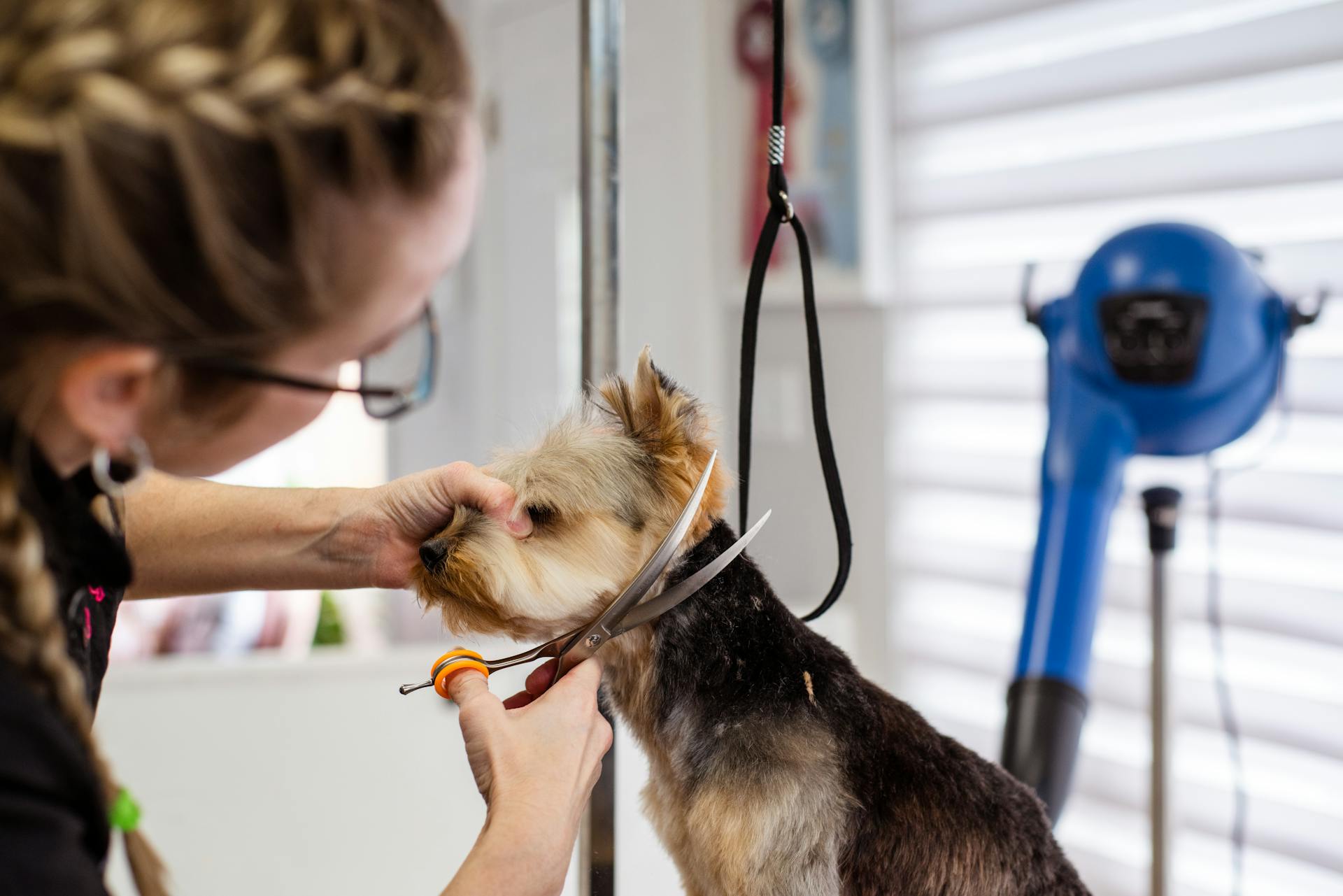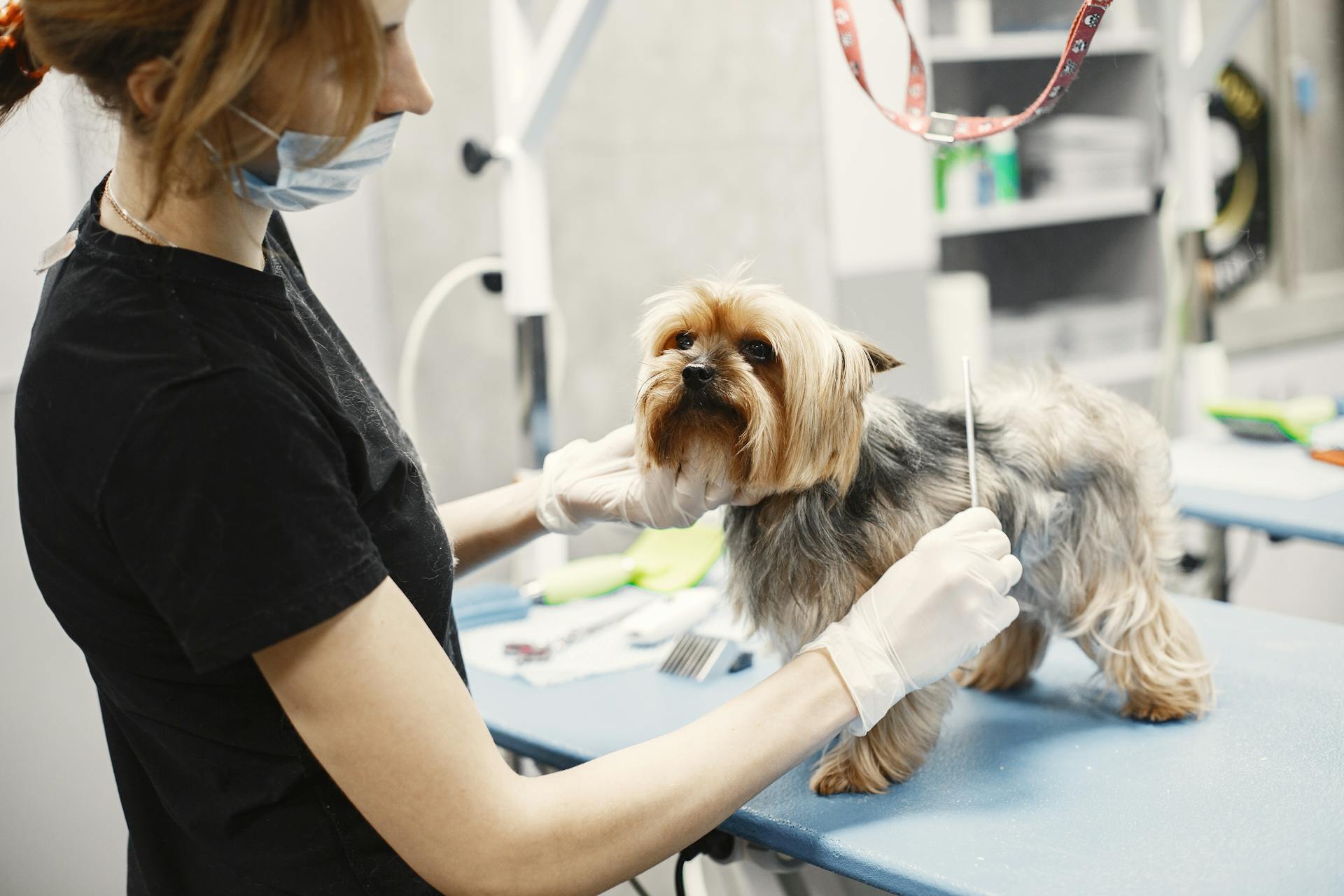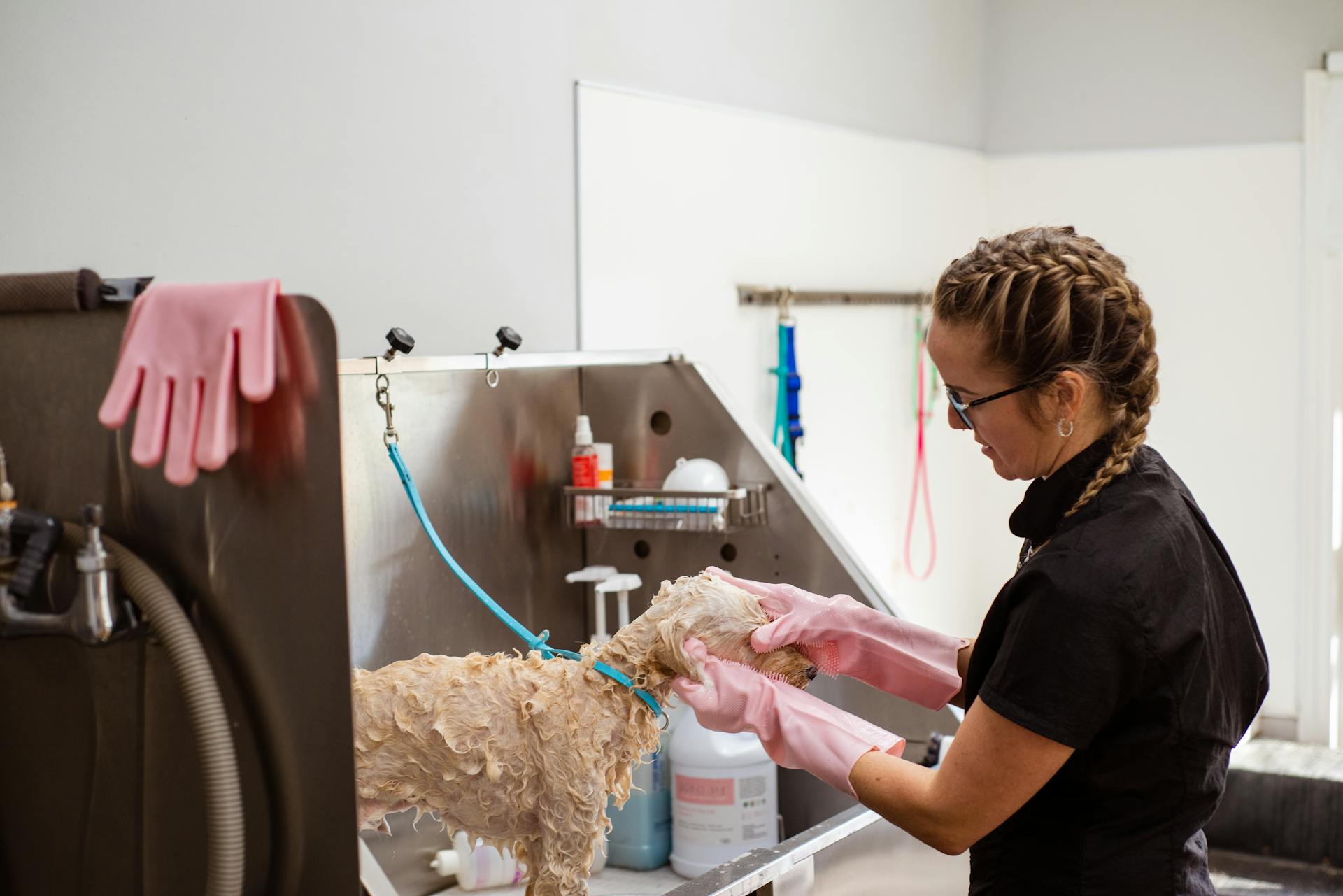
Grooming your dog with scissors requires some basic knowledge and practice to get it right. It's essential to know the right techniques and tools to avoid cutting or hurting your dog.
Using the right scissors is crucial, and there are different types designed specifically for dog grooming. In fact, thinning scissors are perfect for removing tangles and mats, while curved scissors are ideal for trimming around the face and ears.
Before you start grooming, make sure your dog is comfortable and relaxed. A well-groomed dog is a happy dog, and regular grooming can help strengthen the bond between you and your pet.
Recommended read: How to Use Curved Scissors for Dog Grooming
Choosing Scissors
Choosing the right scissors is crucial for a successful dog grooming session. Dog grooming scissors are designed specifically for the purpose, with features like rounded tips and comfortable handles, allowing for smooth and safe cutting.
Using regular household scissors is not suitable for dog grooming, as they are not designed with the specific needs of your pet in mind. Dog hair is much thicker than human hair, and using the wrong type of scissors will blunt even faster for dogs with difficult coats.
There are various types of scissors available, each serving a specific purpose. Straight scissors are the most common type and are used for general trimming and shaping. Thinning scissors, also known as blending shears, have teeth-like serrations and are used to thin out thick coats.
Curved scissors have a curved blade, which allows for more precise cutting around rounded areas. Safety-tip scissors have rounded tips to prevent accidental poking or scratching while grooming sensitive areas. Investing in a good pair of grooming scissors is essential for achieving the best results.
You can get scissors sharpened, but it's recommended to start with a higher quality scissor when budget allows, which will stay sharper for much longer and be able to be sharpened with better results. Geib and Witte Roseline are the best-selling scissor brands, with Geib offering a range of scissor levels for all experience levels.
On a similar theme: Curved Chunkers Dog Grooming
Preparing Your Dog
Start with a calm environment, choosing a quiet and comfortable space for grooming your dog. Minimize distractions and ensure the temperature is pleasant.
Brush your dog's coat to remove any tangles or mats before trimming. This will make the trimming process easier and prevent pulling or discomfort.
Get your dog used to handling by gently touching and massaging the areas you'll be grooming. This will help your dog become accustomed to the sensation.
Familiarize your dog with the grooming tools by letting them sniff and investigate before using them. This will help alleviate any fear or anxiety they may have.
To prepare your dog for grooming, take these steps:
- Start with a calm environment
- Brush your dog's coat
- Get your dog used to handling
- Familiarize your dog with the grooming tools
- Take breaks and offer rewards
By following these steps, you'll create a positive and stress-free environment for both you and your furry friend.
Grooming Techniques
Using the right scissors is crucial for dog grooming. The article highlights the importance of choosing scissors with a rounded tip to prevent accidental cuts.
To achieve a smooth cut, it's essential to use thinning scissors or curved scissors, as mentioned in the article. This type of scissors helps to reduce shedding and prevent matting.
When grooming a dog with scissors, it's crucial to work in small sections to avoid overwhelming the dog. This technique also helps to prevent mistakes and ensures a more even cut.
Handling and Positioning Techniques
Handling and positioning techniques are crucial for safe and effective dog grooming. Hold the scissors correctly with your thumb in one handle loop and your ring and little fingers in the other loop.
This provides stability and control while cutting. Make sure your dog is in a comfortable position for grooming, using a grooming noose if necessary, to ensure better handling.
Start with small, controlled cuts rather than attempting large cuts at once, allowing for more precision and reducing the risk of accidentally cutting too much hair. Trim with the direction of hair growth to create a smooth and even finish.
Place your fingers between the scissors and your dog's skin to prevent accidental cuts, acting as a barrier and ensuring that you don't trim too close to the skin. By following these handling and positioning techniques, you'll be able to groom your dog confidently and safely.
Chunkers
Chunkers are a great tool for grooming dogs with thick coats, like Collies and Chow Chows.
They're similar to blending shears, but will remove larger amounts of the coat.
The combs on chunkers have a small T-shape, which helps to guide the blades and prevent uneven cuts.
Make sure to pick up these shears if you're looking to take your grooming skills to the next level.
Additional reading: Small Dog Grooming Shears
Tools and Equipment
To get started with dog grooming with scissors, you'll need the right tools and equipment. A good pair of dog grooming scissors is essential, so invest in a pair that's suitable for your dog's coat type and the specific areas you'll be trimming.
A comb and brush are also must-haves for detangling and removing mats in your dog's coat. Use a comb with both wide and narrow teeth to tackle different areas of the coat.
Nail clippers are a crucial part of dog grooming, and you'll want to use nail clippers designed for dogs, as they have safety features to prevent cutting the quick.
Expand your knowledge: Grooming a Dog with Clippers
8-8.5 Inches

If you're looking for a versatile length for body work on all breeds, 8-8.5 inches is a great option. This length is ideal for finishing and is a popular choice among many professionals.
For smaller breeds or those new to the craft, 8-8.5 inch scissors may feel too long. You may want to consider a shorter length to get a feel for the tool.
Browse safety tip ball tip scissors in this length range for added protection.
For your interest: Theory of 5 Dog Grooming
Essential Tools
Having a well-stocked grooming kit is essential for making the process smoother and more efficient.
A good pair of dog grooming scissors is a must-have, and it's crucial to invest in a pair that's suitable for your dog's coat type and the specific areas you'll be trimming.
A comb with both wide and narrow teeth is necessary for detangling and removing mats in your dog's coat. Use this type of comb to tackle different areas of the coat.
Consider reading: Metal Comb for Dog Grooming

Clippers are useful for trimming larger areas of the coat or achieving a uniform length. Choose clippers specifically designed for dog grooming, as they're quieter and have adjustable blade lengths.
Regular nail trimming is essential for your dog's comfort and health. Use nail clippers designed for dogs, which have safety features to prevent cutting the quick.
Accidents can happen, and it's essential to be prepared. Keep styptic powder on hand to help stop bleeding in case you accidentally nick your dog's skin while trimming.
A dedicated grooming table or non-slip mat provides a stable surface for grooming and helps keep your dog in place during the process.
Consider reading: Dog Grooming Nail Trimming
Round-Tip Shears
Round-Tip Shears are your "safety" scissors with rounded edges, making them safer to use in delicate areas such as the face.
These shears are perfect for working on details around the eyes, lip lines, ears, and toes without the fear of a sharp edge causing damage.
You can still get a very sharp cut with Round-Tip Shears, they're not for kindergartners, but for professionals who need to be precise.
ConairPRO Rounded-Tip is a favorite brand for Round-Tip Shears, and they're a must-have for all dogs that you are grooming.
For your interest: Tip for Dog Grooming
Cleaning and Maintenance
Cleaning and maintenance of your tools and equipment is crucial for their performance and longevity. Proper care can make all the difference in getting the job done efficiently and effectively.
Clean your scissors after each use to prevent buildup and keep the blades sharp. This simple habit can save you time and effort in the long run.
Disinfect your scissors regularly to prevent the spread of bacteria or infections. Use a pet-safe disinfectant or warm soapy water to clean the blades thoroughly.
Oil your scissors regularly to ensure smooth cutting and prevent rusting. Apply a few drops of oil to the blades and wipe off any excess oil to maintain optimal performance.
Store your tools and equipment in a clean, dry place, preferably in a protective case or pouch. This will prevent damage and keep them in good condition for future use.
You might like: Dog Grooming Clippers and Blades
Common Issues and Solutions
Sometimes, dog owners may be unsure about which scissors to use for their furry friend's grooming.

Using dull scissors can be frustrating and may lead to uneven cuts or even injuries to your dog.
To avoid this, always use sharp, high-carbon steel scissors specifically designed for dog grooming.
Using the wrong scissors can also lead to matting and tangling of your dog's fur.
To prevent matting, use thinning scissors to gently remove tangles and mats from your dog's coat.
If you're unsure about how to use scissors on your dog's sensitive areas, such as around the eyes or ears, it's best to seek professional help from a veterinarian or a professional dog groomer.
Using scissors on your dog's paws can be a bit tricky, but it's essential for maintaining their overall health and hygiene.
To make the process easier, use curved scissors to carefully trim the hair around your dog's paws, taking care not to cut the quick.
Recommended read: Dog Grooming Kit Professional
Grooming Levels and Ranges
AllGroom stocks 4 scissor brands, with Geib and Witte Roseline being the best sellers. Geib scissors come in levels 1, 2, and 3, while Witte Roseline offers levels 1 and 2. Wahl and Shernbao are more affordable options, suitable for home users.
There are three main scissor levels, each catering to different experience levels and grooming needs. Level 3 is a smaller range, reserved for Master Groomers, experienced groomers, and those who specialize in breeds with high scissor use, such as Bichons, Poodles, or Pomeranians.
4.5-6.5 inches
These shorter scissors, typically ranging from 4.5 to 6.5 inches, are perfect for delicate areas like the face and feet.
They're also great for toy breeds, providing the precision needed for body use.
These lengths are available in safety-tip scissors, which have rounded, blunt ends for extra protection from injury.
You can browse 8” to 8.5” scissors, but these shorter lengths are ideal for precise work.
Level 1
Level 1 scissors are dual-purpose, designed for beginners and grooming students, but also popular with experienced groomers who use them as their 'workhorse' shears.
They're great for getting one scissor that 'does it all', making them a good choice for those who want a versatile pair.
You can check out the Gator and Gator 008 in particular, as they're highly recommended for beginners and those looking to upgrade without needing a finishing scissor.
Level 1 scissors are also popular for difficult coats and for block or rough work, like the initial cut-down, and are tough enough to handle 'oodle and other difficult coat types.
They have a nice balance, being a little heavier and more robust, usually with a micro-serrated edge to help 'hold' the hair as you cut.
Here's an interesting read: Grooming a Difficult Dog
Level 3
Level 3 scissor ranges are smaller and more specialized, typically reserved for experienced groomers and those who work with breeds that require high scissor use, such as Bichons, Poodles, or Pomeranians.
These levels are often used by Master Groomers, experienced groomers, and breeders for showring preparation. Geib's Poodle Hi-Tech meets the requirements for Level 3 rank.
This level is not for beginners, as it requires a high level of skill and expertise to handle the more delicate and intricate cuts of these breeds.
Broaden your view: All Breeds Dog Grooming
Grooming Station and Supplies
To set up a grooming station, you'll want to get a full set of grooming scissors. Each type has a specific purpose, so it's essential to have them all to make grooming easier.
You'll need to make sure the scissors are sharp and oiled before you start. Dull scissors can cause pain and stress to your dog, so it's crucial to keep them sharp.
To keep your scissors sharp, you may need to sharpen them if they've been used several times. Putting a few drops of scissor oil on the blades before you begin will also make cutting easier.
Readers also liked: Dog Grooming Setup
To clean your tools thoroughly every time you trim your dog, you can spray or wipe them with a household disinfectant, like Lysol or Clorox, or you can dip them into boiling water for 1 minute.
To make clean-up easier, place a mat underneath your dog to catch most of the flying hair. This will save you time and effort in the long run.
Here's a list of the tools you'll need:
- Full set of grooming scissors
- Scissor oil
- Household disinfectant (like Lysol or Clorox)
- Boiling water
- Grooming mat
Frequently Asked Questions
How to groom dogs' faces with scissors?
To groom a dog's face with scissors, start by combing the fur upwards and trimming the beard with curved scissors, working around the eyebrow level. This will help keep the muzzle neat and tidy.
Sources
- https://www.clipit-grooming.com/post/how-to-use-dog-grooming-scissors-safely-and-effectively-tips-from-the-pros
- https://www.learn2groomdogs.com/scissor-leg-2-minutes/
- https://www.wikihow.pet/Cut-Dog-Hair-with-Scissors
- https://allgroom.co.nz/blogs/scissors/guide-choosing-comparing-dog-grooming-scissors
- https://www.petcareins.com/blog/professional-dog-grooming-supplies-guide
Featured Images: pexels.com


